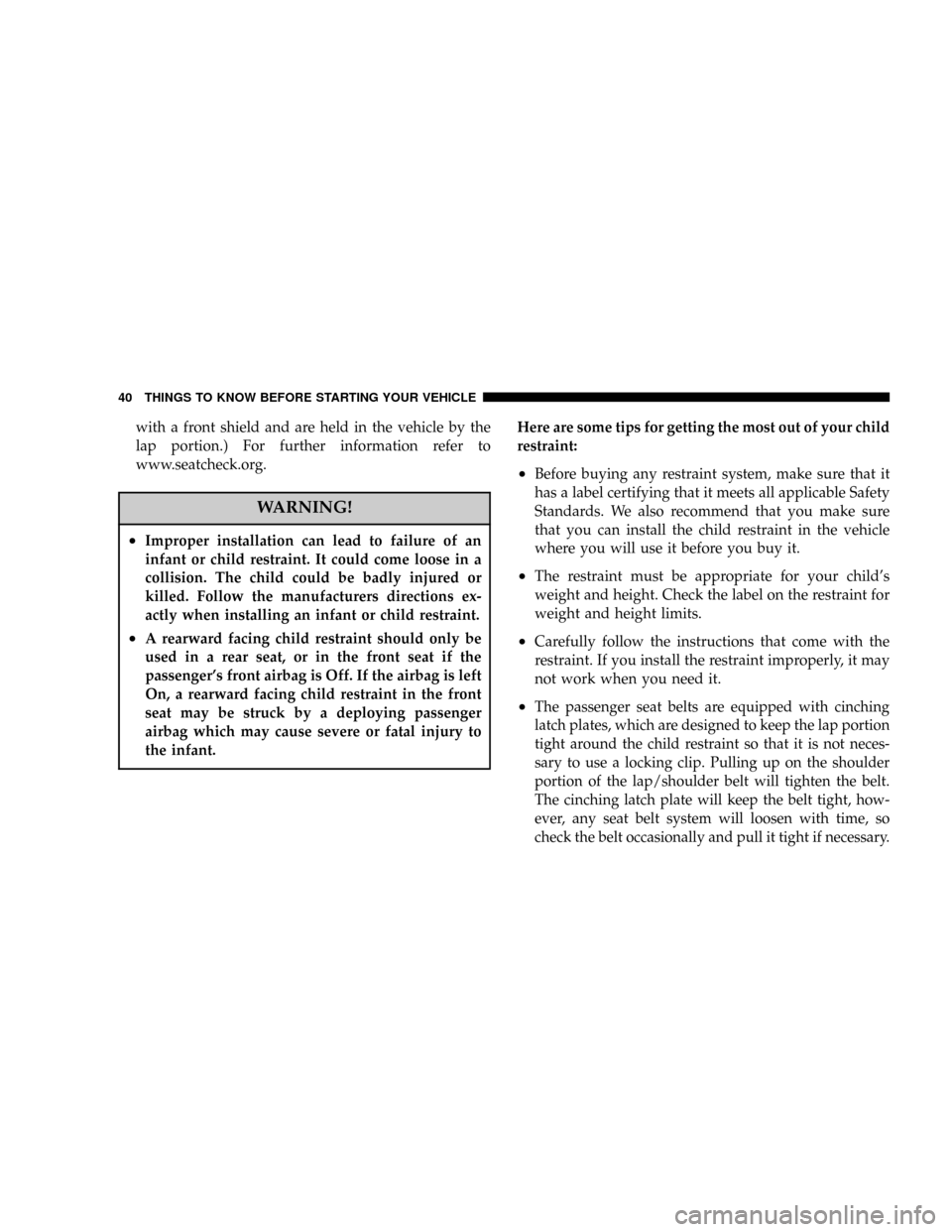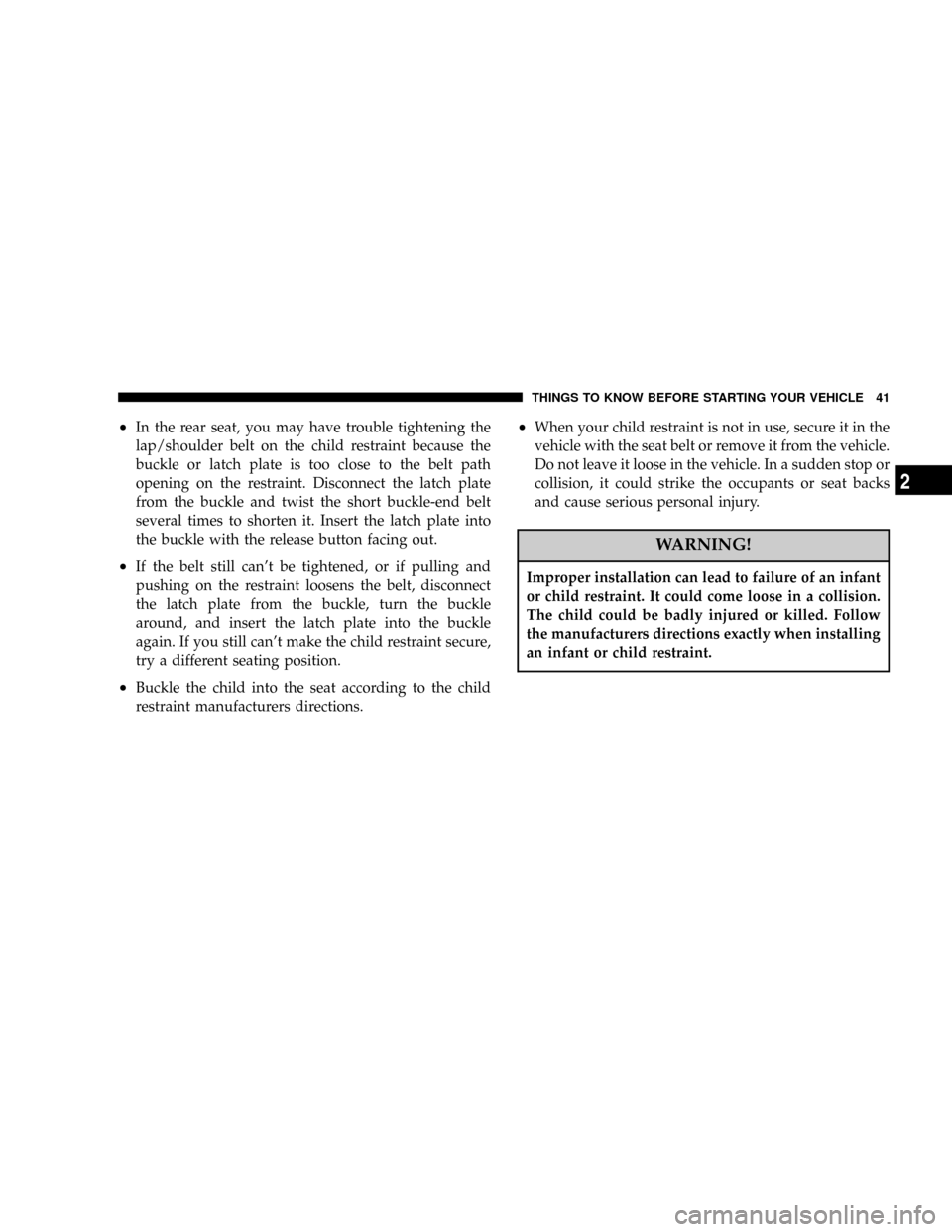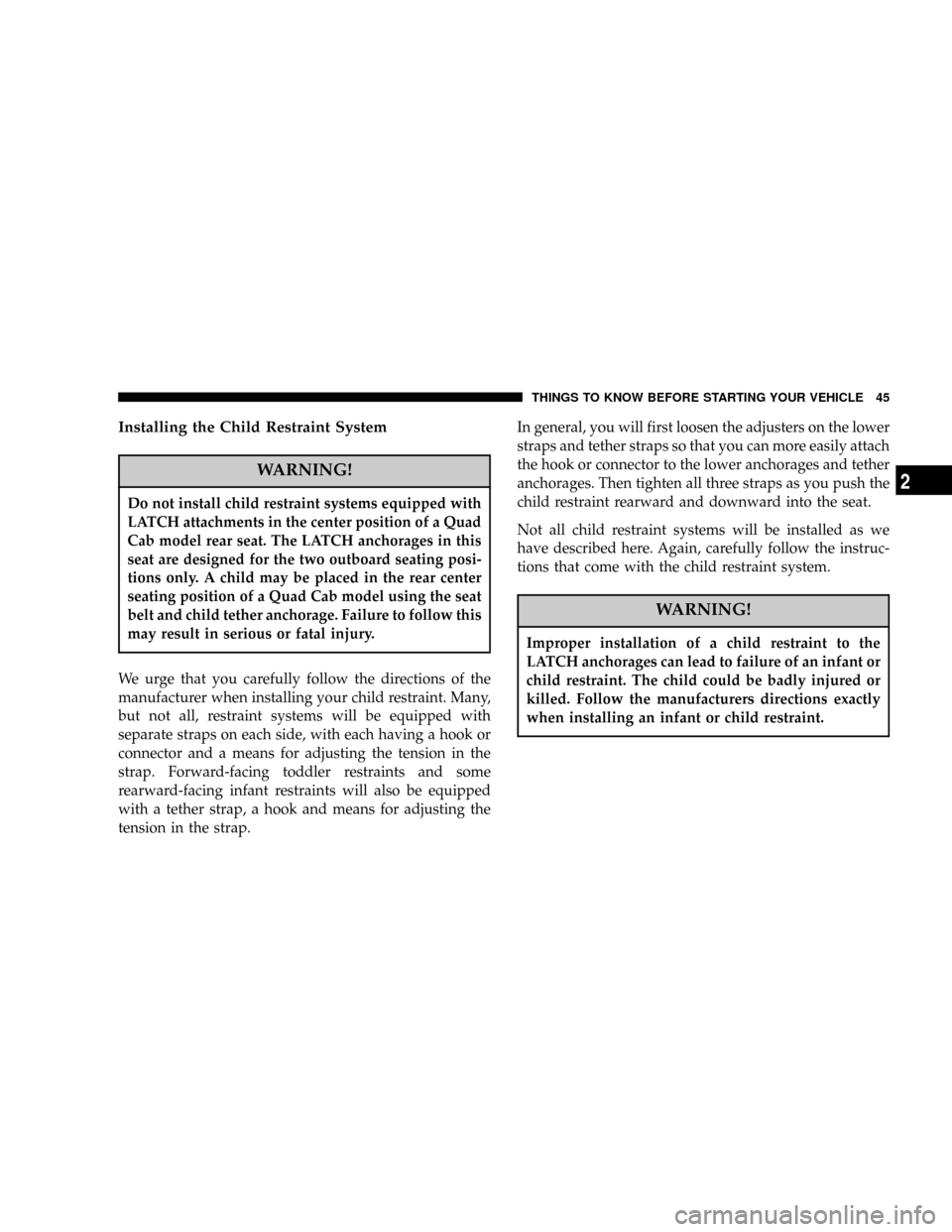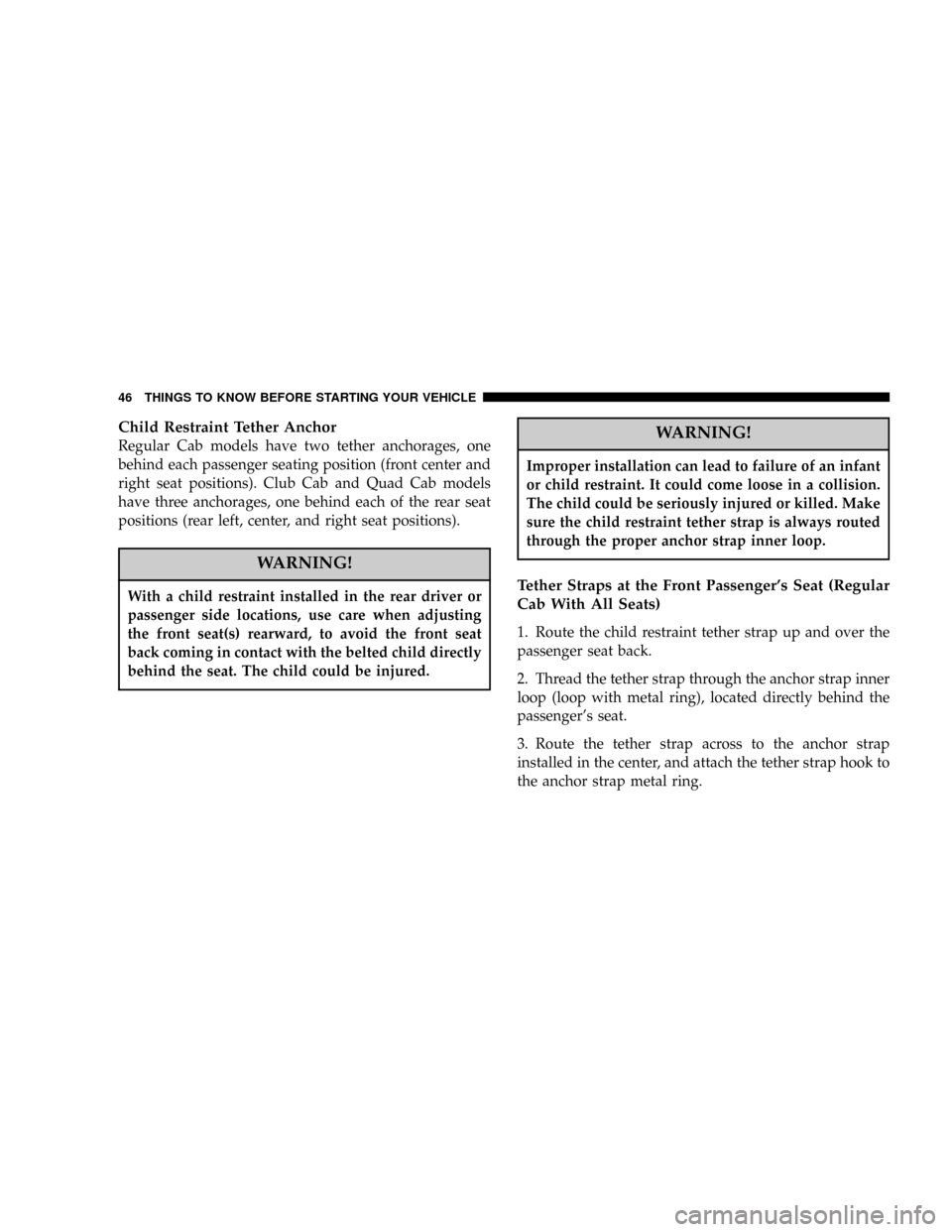Page 40 of 300

with a front shield and are held in the vehicle by the
lap portion.) For further information refer to
www.seatcheck.org.
WARNING!
²Improper installation can lead to failure of an
infant or child restraint. It could come loose in a
collision. The child could be badly injured or
killed. Follow the manufacturers directions ex-
actly when installing an infant or child restraint.
²A rearward facing child restraint should only be
used in a rear seat, or in the front seat if the
passenger's front airbag is Off. If the airbag is left
On, a rearward facing child restraint in the front
seat may be struck by a deploying passenger
airbag which may cause severe or fatal injury to
the infant.
Here are some tips for getting the most out of your child
restraint:
²Before buying any restraint system, make sure that it
has a label certifying that it meets all applicable Safety
Standards. We also recommend that you make sure
that you can install the child restraint in the vehicle
where you will use it before you buy it.
²The restraint must be appropriate for your child's
weight and height. Check the label on the restraint for
weight and height limits.
²Carefully follow the instructions that come with the
restraint. If you install the restraint improperly, it may
not work when you need it.
²The passenger seat belts are equipped with cinching
latch plates, which are designed to keep the lap portion
tight around the child restraint so that it is not neces-
sary to use a locking clip. Pulling up on the shoulder
portion of the lap/shoulder belt will tighten the belt.
The cinching latch plate will keep the belt tight, how-
ever, any seat belt system will loosen with time, so
check the belt occasionally and pull it tight if necessary.
40 THINGS TO KNOW BEFORE STARTING YOUR VEHICLE
Page 41 of 300

²In the rear seat, you may have trouble tightening the
lap/shoulder belt on the child restraint because the
buckle or latch plate is too close to the belt path
opening on the restraint. Disconnect the latch plate
from the buckle and twist the short buckle-end belt
several times to shorten it. Insert the latch plate into
the buckle with the release button facing out.
²If the belt still can't be tightened, or if pulling and
pushing on the restraint loosens the belt, disconnect
the latch plate from the buckle, turn the buckle
around, and insert the latch plate into the buckle
again. If you still can't make the child restraint secure,
try a different seating position.
²Buckle the child into the seat according to the child
restraint manufacturers directions.
²When your child restraint is not in use, secure it in the
vehicle with the seat belt or remove it from the vehicle.
Do not leave it loose in the vehicle. In a sudden stop or
collision, it could strike the occupants or seat backs
and cause serious personal injury.
WARNING!
Improper installation can lead to failure of an infant
or child restraint. It could come loose in a collision.
The child could be badly injured or killed. Follow
the manufacturers directions exactly when installing
an infant or child restraint.
THINGS TO KNOW BEFORE STARTING YOUR VEHICLE 41
2
Page 42 of 300
Lower Anchors and Tether for CHildren (LATCH)
Each vehicle is equipped with the child restraint anchor-
age system called LATCH, which stands for Lower
Anchors and Tether for CHildren. LATCH child restraint
anchorage systems are installed in the Standard Cab
passenger seat position, the Club Cab front passenger
and rear outboard right side positions and the Quad Cab
rear seat outboard positions and also feature tether strap
anchorages, which must be used, located behind the
seatback (refer to Child Restraint Tether Anchor later in
this section).
Standard and Club Cab Front Seat
42 THINGS TO KNOW BEFORE STARTING YOUR VEHICLE
Page 44 of 300

NOTE:For children riding in the front seat of a
Standard Cab model refer to the ªPassenger Airbag
On/Off Switchº located in this section.
Child restraint systems having attachments designed to
connect to the lower anchorages are now available. Child
restraints having tether straps and hooks for connection
to the seatback tether anchorage have been available for
some time. In fact, many child restraint manufacturers
will provide add-on tether strap kits for some of their
older products.Because the lower anchorages are to be introduced to
passenger carrying vehicles over a period of years, child
restraint systems having attachments for those anchor-
ages will continue to have features for installation in
vehicles using the lap or lap/shoulder belt. They will also
have tether straps, and you are urged to take advantage
of all of the available attachments provided with your
child restraint in any vehicle.
NOTE:If your child restraint seat is not LATCH
compatible, install the restraint using the vehicle seat
belting.
Quad Cab Rear Left Seat
44 THINGS TO KNOW BEFORE STARTING YOUR VEHICLE
Page 45 of 300

Installing the Child Restraint System
WARNING!
Do not install child restraint systems equipped with
LATCH attachments in the center position of a Quad
Cab model rear seat. The LATCH anchorages in this
seat are designed for the two outboard seating posi-
tions only. A child may be placed in the rear center
seating position of a Quad Cab model using the seat
belt and child tether anchorage. Failure to follow this
may result in serious or fatal injury.
We urge that you carefully follow the directions of the
manufacturer when installing your child restraint. Many,
but not all, restraint systems will be equipped with
separate straps on each side, with each having a hook or
connector and a means for adjusting the tension in the
strap. Forward-facing toddler restraints and some
rearward-facing infant restraints will also be equipped
with a tether strap, a hook and means for adjusting the
tension in the strap.In general, you will first loosen the adjusters on the lower
straps and tether straps so that you can more easily attach
the hook or connector to the lower anchorages and tether
anchorages. Then tighten all three straps as you push the
child restraint rearward and downward into the seat.
Not all child restraint systems will be installed as we
have described here. Again, carefully follow the instruc-
tions that come with the child restraint system.
WARNING!
Improper installation of a child restraint to the
LATCH anchorages can lead to failure of an infant or
child restraint. The child could be badly injured or
killed. Follow the manufacturers directions exactly
when installing an infant or child restraint.
THINGS TO KNOW BEFORE STARTING YOUR VEHICLE 45
2
Page 46 of 300

Child Restraint Tether Anchor
Regular Cab models have two tether anchorages, one
behind each passenger seating position (front center and
right seat positions). Club Cab and Quad Cab models
have three anchorages, one behind each of the rear seat
positions (rear left, center, and right seat positions).
WARNING!
With a child restraint installed in the rear driver or
passenger side locations, use care when adjusting
the front seat(s) rearward, to avoid the front seat
back coming in contact with the belted child directly
behind the seat. The child could be injured.
WARNING!
Improper installation can lead to failure of an infant
or child restraint. It could come loose in a collision.
The child could be seriously injured or killed. Make
sure the child restraint tether strap is always routed
through the proper anchor strap inner loop.
Tether Straps at the Front Passenger's Seat (Regular
Cab With All Seats)
1. Route the child restraint tether strap up and over the
passenger seat back.
2. Thread the tether strap through the anchor strap inner
loop (loop with metal ring), located directly behind the
passenger's seat.
3. Route the tether strap across to the anchor strap
installed in the center, and attach the tether strap hook to
the anchor strap metal ring.
46 THINGS TO KNOW BEFORE STARTING YOUR VEHICLE
Page 47 of 300
4. Remove the slack in the tether strap so that both
anchor straps are pulled tight.Tether Straps at the Front Center Seat (Regular Cab
With Any Bench Seat)
1. Route the child restraint tether strap up and over the
center seat back.
2. Thread the tether strap through the anchor strap inner
loop (loop with metal ring), located directly behind the
center seat.
3. Route the tether strap across to the anchor strap
installed directly behind the passenger's seat location,
and attach the tether strap hook to the anchor strap metal
ring.
Regular Cab With All Seats
THINGS TO KNOW BEFORE STARTING YOUR VEHICLE 47
2
Page 48 of 300
4. Remove the slack in the tether strap so that both
anchor straps are pulled tight.
Tether Strap at the Front Passenger Seat (Club Cab)
1. Route the child restraint tether strap up and over the
front passenger seat back.
2. Connect the tether strap to the lower anchorage.3. Remove the slack in the tether strap so that it is pulled
tight.
Regular Cab With Any Bench Seat
Club Cab Front Passenger Seat
48 THINGS TO KNOW BEFORE STARTING YOUR VEHICLE